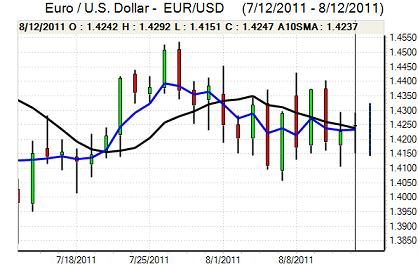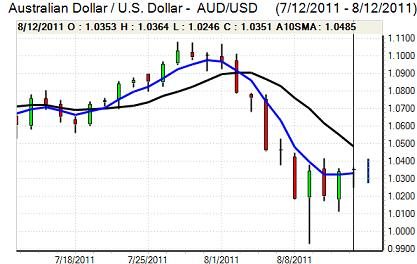EUR/USD
The Euro again found support on dips towards 1.4150 against the dollar during Friday and rallied to a high near 1.43 before initially faltering again as risk appetite dipped once again.
The US retail sales data provided some relief from recent gloom with the headline and core readings both recording a 0.5% increase for July which was slightly higher than expected. In contrast, the University of Michigan consumer confidence index was sharply weaker than expected with a decline to 54.9 for August from 63.7 previously and this was the lowest reading since 1980.
There were further concerns that weak confidence would undermine spending over the next few months, especially with the risk that high volatility in equity markets would discourage spending. Overall, there was a tentative improvement in risk appetite which helped curb immediate dollar demand. There was, however, further evidence of stresses within the credit markets as swap rates indicated a growing dollar shortage with Libor rates also increasing to the highest level since April
There were domestic protests against the Italian austerity measures which dampened the favourable market reaction while the Italian government again called for the issuance of Eurobonds. There were reports that the German government could consider Eurobonds as a last-resort measure to protect the Euro, but domestic opposition will remain extremely high.. There was also a sharp decline in net short speculative dollar positions which will make it difficult to rally further, but there was also still high demand for Euro puts as fear persisted.
Risk conditions remained generally more favourable in Asia on Monday which allowed a Euro challenge above 1.43 where tough resistance was being encountered.

Source: VantagePoint Intermarket Analysis Software
Call now and you will be provided with FREE recent forecasts
that are up to 86% accurate * 800-732-5407
If you would rather have the recent forecasts sent to you, pleasego here
Yen
The dollar attempted to rally following the US retail sales data on Friday and again in Asian trading on Monday, but there was further resistance above the 77 level against the yen.
Domestically, there was a 0.3% contraction for GDP in the second quarter which was the third consecutive decline, although the fall was not as bad as expected and there were important signs of recovery.
Yield considerations remained important and the yield spread between US and Japanese rates on two-year bonds narrowed to the lowest level since 1992 which was an important factor in undermining potential dollar support.
Finance Minister Noda continued to warn over the potential for intervention if one-sided moves continued and there was further speculation that any decisive move by the Swiss National Bank to stem franc appreciation would also increase Japanese resistance to yen gains.
Sterling
Sterling found support around 1.6170 against the dollar on Friday and advanced to a high around 1.63 in Asian trading on Monday as the US currency lost support. Sterling found support near 0.88 against the Euro, but was unable to make much headway.
Confidence in the UK economy remains frail and this continued to have some negative Sterling impact with markets reluctant to push the currency stronger. The data this week will be watched closely, even though the immediate policy implications may be limited. The Bank of England has effectively confirmed that interest rates will remain on hold for the next few months while the bank is likely to want more evidence before considering any expansion of quantitative easing.
Any comments from ratings agencies will be watched very closely as there will be market speculation over a cut if there is evidence of further domestic economic deterioration. Rightmove reported a 2.2% decline in asking prices for the UK housing sector for August to give a 0.3% annual decline.
Swiss franc
The franc remained under pressure during Friday and retreated to lows beyond 1.1050 against the Euro while the dollar edged higher to the 0.7750 area. Immediate demand for the franc was dampened by a cautious improvement in risk appetite.
National Bank policy intensions also remained an extremely important focus amid further speculation that they would take additional action to stem franc gains. There were comments in the weekend press which suggested that the bank would introduce a new minimum level for the franc against the Euro, possibly just above the 1.10 level and would employ all measures to defend this level.
This speculation pushed the franc to lows just beyond 0.79 against the dollar in Asia on Monday with the Euro testing resistance above 1.13.

Source: VantagePoint Intermarket Analysis Software
Call now and you will be provided with FREE recent forecasts
that are up to 86% accurate * 800-732-5407
If you would rather have the recent forecasts sent to you, pleasego here
Australian dollar
The Australian dollar found support near 1.0250 against the US currency on Friday and rallied to a high above 1.0420 against the US currency in local trading on Monday. The currency derived some support from an improvement in risk appetite while there was also a rally in industrial commodity prices which provided some support.
There was further unease over the economic outlook, but a recovery in car sales provided some relief from the recent data weakness. There will still be fears over an underlying slowdown in the economy.



